Effect of Anionic Polyacrylamide Polymer on Frost Heave Mitigation and Its Implication for Frost-Susceptible Soil
Abstract
:1. Introduction
2. Methodology
2.1. Experimental Material
2.2. Experimental Apparatus
2.3. Experimental Procedures
- (1)
- Assembly of the sample. Firstly, the soil samples were installed into the Plexiglas cube, and the cold end which can freeze the soil sample from top down was placed at the top of the soil sample. Secondly, the displacement sensor (measurement range of 50 mm) was applied at the top of soil sample. Moreover, eight thermal resistors embedded along the soil sample (at different heights of 15 mm, 40 mm, 65 mm, 90 mm, 115 mm, 140 mm, 165 mm, and 190 mm) were applied to monitor temperature.
- (2)
- A thermostatic process. Both the warm end and cold end were maintained at 5 °C (500 min) until the temperature was longitudinally and uniformly distributed along the soil samples. It is noted that the thermotank was switched on and controlled at a constant temperature of 5 °C in the meantime.
- (3)
- Soil freezing process. The warm end of the soil sample and thermotank were continuously kept at 5 °C, and the cold end initiated a cold temperature of −20 °C. The cold end temperature can subsequently enable a progressively downward movement of the freezing front.
- (4)
- Data logging. Data taker loggers were used to collect the temperature at different positions of the soil samples and to collect the movement of soil surface (frost heave). These measurements occurred at 10 min intervals during freezing. After frost heave experiments, the soil columns were sliced into several soil columns of 1 cm in height, and water distribution was subsequently determined using a drying method (using a thermostat drying box).
3. Results
3.1. Frost Heave Test
3.1.1. Temperature and Temperature Gradient
3.1.2. Frost Heave Using Different Contents of APAM
3.1.3. Distribution of Water Content
3.1.4. Shear Strength of APAM-Modified Soil
3.1.5. Viscosity and Permeability of APAM-Modified Soil
3.2. SEM Results
3.3. FTIR Results
4. Discussion
5. Conclusions
- (1)
- APAM polymers significantly slow down frost heave velocity, and less water was observed redistributed in the soil column with increasing APAM content (the maximum water content near the frozen fringe decreases from 53.4% to 31.4% as APAM content increases from 0.0% to 0.60%). Frost heave is mitigated with the addition of APAM polymer, and 0.60% APAM can slow down the frost heave by a factor of 2.1 (8.56 mm divided by 4.14 mm).
- (2)
- The adsorption of APAM onto soil particles originated from hydrogen bonding-induced physical adsorption (FTIR results demonstrate that no newly formed peaks are observed), and 0.60% APAM contributes a 20 kPa increase in cohesion force. The bridging adsorption can occur among the soil particles via hydrogen bonding, thus facilitating the aggregation of soil particles (enhancing soil cohesion) and causing difficulty in the formation of the ice lens.
- (3)
- The addition of APAM can thicken the fluid and narrow seepage channels, thus enhancing the fluid viscosity and decreasing soil permeability. The viscosity increases from 0.0 to 2.0 × 103 as APAM content increases from 0.0% to 0.30%, and the corresponding soil permeability decreases from 4.2 to 1.0 × 10−5 . These processes inevitably inhibit the feed of external water to the bottom of the ice lens and affect the growth of the ice lens (frost heave).
Author Contributions
Funding
Institutional Review Board Statement
Data Availability Statement
Acknowledgments
Conflicts of Interest
References
- Niu, F.; Zheng, H.; Li, A. The study of frost heave mechanism of high-speed railway foundation by field-monitored data and indoor verification experiment. Acta Geotech. 2018, 15, 581–593. [Google Scholar] [CrossRef]
- Long, X.; Cen, G.; Cai, L.; Chen, Y. Model experiment of uneven frost heave of airport pavement structure on coarse-grained soils foundation. Constr. Build. Mater. 2018, 188, 372–380. [Google Scholar] [CrossRef]
- Mahedi, M.; Cetin, B.; Cetin, K.S. Freeze-thaw performance of phase change material (PCM) incorporated pavement subgrade soil. Constr. Build. Mater. 2019, 202, 449–464. [Google Scholar] [CrossRef]
- Liu, H.; Ma, D.; Wang, C.; Liu, X.; Wu, D.; Khan, K.U.J. Study on the frost heave mechanism of the water conveyance canal and optimized design of slope protection. Bull. Eng. Geol. Environ. 2021, 80, 8397–8417. [Google Scholar] [CrossRef]
- Hu, Y.; Hou, X.; Zhang, Y.; Wang, Z.; Li, B. Heat and water transfers for the frost heave behavior of freezing graded soil. Int. Commun. Heat Mass Transf. 2023, 143, 106687. [Google Scholar] [CrossRef]
- Ji, Y.; Zhou, G.; Vandeginste, V.; Zhou, Y. Thermal-hydraulic-mechanical coupling behavior and frost heave mitigation in freezing soil. Bull. Eng. Geol. Environ. 2021, 80, 2701–2713. [Google Scholar] [CrossRef]
- Xue, K.; Wen, Z.; Zhu, Z.; Wang, D.; Luo, F.; Zhang, M. An experimental study of the relationship between the matric potential, unfrozen water, and segregated ice of saturated freezing soil. Bull. Eng. Geol. Environ. 2021, 80, 2535–2544. [Google Scholar] [CrossRef]
- Li, Z.; Liu, S.; Feng, Y.; Liu, K.; Zhang, C. Numerical study on the effect of frost heave prevention with different canal lining structures in seasonally frozen ground regions. Cold Reg. Sci. Technol. 2013, 85, 242–249. [Google Scholar] [CrossRef]
- Reidmiller, D.R.; Avery, C.W.; Easterling, D.R.; Kunkel, K.E.; Lewis, K.L.M.; Maycock, T.K.; Stewart, B.C. Fourth National Climate Assessment, Volume II: Impacts, Risks, and Adaptation in the United States; Report-in-Brief; U.S. Global Change Research Program: Washington, DC, USA, 2019.
- Rosa, M.G.; Cetin, B.; Edil, T.B.; Benson, C.H. Freeze-thaw performance of fly ash-stabilized materials and recycled pavement materials. J. Mater. Civ. Eng. 2017, 29, 04017015. [Google Scholar] [CrossRef]
- Li, X.; Wu, Q.; Jin, H. Mitigation strategies and measures for frost heave hazards of chilled gas pipeline in permafrost regions: A review. Transp. Geotech. 2022, 36, 100786. [Google Scholar] [CrossRef]
- Mahedi, M.; Satvati, S.; Cetin, B.; Daniels, J.L. Chemically induced water repellency and the freeze-thaw durability of soils. J. Cold Reg. Eng. 2020, 34, 04020017. [Google Scholar] [CrossRef]
- Johnson, A.E. Freeze-Thaw Performance of Pavement Foundation Materials. Master’s Thesis, Iowa State University, Ames, IA, USA, 2012. [Google Scholar]
- Zhang, Y.; Johnson, A.E.; White, D.J. Freeze-thaw performance of cement and fly ash stabilized loess. Transp. Geotech. 2019, 21, 100279. [Google Scholar] [CrossRef]
- Zhang, Y.; Johnson, A.E.; White, D.J. Laboratory freeze-thaw assessment of cement, fly ash, and fiber stabilized pavement foundation materials. Cold Reg. Sci. Technol. 2016, 122, 50–57. [Google Scholar] [CrossRef]
- Lokeshappa, B.; Dikshit, A.K. Fate of metals in coal fly ask ponds. Int. J. Environ. Sci. Dev. 2012, 3, 43–48. [Google Scholar]
- Tiwari, M.K.; Bajpai, S.; Dewangan, U.K.; Tamrakar, R.K. Suitability of leaching test methods for fly ash and slag: A review. J. Radiat. Res. Appl. 2015, 8, 523–537. [Google Scholar] [CrossRef]
- Jadoon, S.; Amin, A.A.; Malik, A.; Kamal, H. Soil pollution by the cement industry in the Bazian vicinity, Kurdistan region. J. Environ. Anal. Toxicol. 2016, 6, 1000413. [Google Scholar] [CrossRef]
- Asitok, A.; Ekpenyong, M.; Antai, S. Multivariate statistics of fertility parameter fluxes in cement-dust-polluted soils in Mfamosing, Nigeria: Impact on agriculture. J. Microbiol. Biotechnol. Food Sci. 2020, 9, 781–789. [Google Scholar] [CrossRef]
- Georgees, R.N.; Hassan, R.A.; Evans, R.P.; Jegatheesan, P. Resilient response characterization of pavement foundation materials using a polyacrylamide-based stabilizer. J. Mater. Civ. Eng. 2018, 30, 04017252. [Google Scholar] [CrossRef]
- Zhang, T.; Deng, Y.; Lan, H.; Zhang, F.; Zhang, H.; Wang, C.; Tan, Y.; Yu, R. Experimental investigation of the compactability and cracking behavior of polyacrylamide-treated saline soil in Gansu province, China. Polymers 2019, 11, 90. [Google Scholar] [CrossRef]
- Qi, C.; Bai, Y.; Liu, J.; Bu, F.; Kanungo, D.P.; Song, Z.; He, X. Desiccation cracking behavior of polyurethane and polyacrylamide admixed clayey soils. Polymers 2020, 12, 2398. [Google Scholar] [CrossRef]
- Lei, H.; Lou, J.; Li, X.; Jiang, M.; Tu, C. Stabilization effect of anionic polyacrylamide on marine clay treated with lime. Int. J. Geomech. 2020, 20, 04020050. [Google Scholar] [CrossRef]
- Fijałkowska, G.; Szewczuk-Karpisz, K.; Wiśniewska, M. Anionic polyacrylamide influence on the lead(II) ion accumulation in soil—The study on montmorillonite. J. Environ. Health Sci. 2020, 18, 599–607. [Google Scholar] [CrossRef]
- Haghollahi, A.; Fazaelipoor, M.H.; Schaffie, M. The effect of soil type on the bioremediation of petroleum contaminated soils. J. Environ. Manag. 2016, 180, 197–201. [Google Scholar] [CrossRef]
- Stempkowska, A.; Wójcik, Ł.; Ostrowski, K.A.; Gawenda, T. Low-energy clay–cement slurries find application as waterproofing membranes for limiting the migration of contaminants-case studies in Poland. Energies 2023, 16, 230. [Google Scholar] [CrossRef]
- Ji, Y.; Zhou, G.; Zhou, Y.; Vandeginste, V. Frost heave in freezing soils: A quasi-static model for ice lens growth. Cold Reg. Sci. Technol. 2019, 158, 10–17. [Google Scholar] [CrossRef]
- Zhou, J.; Wei, C. Ice lens induced interfacial hydraulic resistance in frost heave. Cold Reg. Sci. Technol. 2020, 171, 102964. [Google Scholar] [CrossRef]
- Ji, Y.; Zhou, G.; Zhao, X.; Wang, J.; Wang, T.; Lai, Z.; Mo, P. On the frost heaving-induced pressure response and its dropping power-law behaviors of freezing soils under various restraints. Cold Reg. Sci. Technol. 2017, 142, 25–33. [Google Scholar] [CrossRef]
- JGJ118-2011; Code for Design of Soil and Foundation of Building in Frozen Soil Region. China Architecture & Building Press: Beijing, China, 2011.
- Zhou, G.; Zhou, Y.; Hu, K.; Wang, Y.J.; Shang, X.Y. Separate-ice frost heave model for one-dimensional soil freezing process. Acta Geotech. 2018, 13, 207–217. [Google Scholar] [CrossRef]
- Bai, R.; Lai, Y.; You, Z.; Ren, J. Simulation of heat–water–mechanics process in a freezing soil under stepwise freezing. Permafr. Periglac. 2020, 31, 200–212. [Google Scholar] [CrossRef]
- Wang, H.; She, D.; Fei, Y.; Tang, S. Synergic effects of biochar and polyacrylamide amendments on the mechanical properties of silt loam soil under coastal reclamation in China. Catena 2019, 182, 104152. [Google Scholar] [CrossRef]
- Yang, A.; Liao, Y.; An, M.; Cao, Y.; Yang, Z.; Ren, H.; Su, H.; Zou, Q.; Chen, L. Effect of ultrasonic pretreatment on flocculation filtration of low-rank coal slurry. Molecules 2022, 27, 6460. [Google Scholar] [CrossRef]
- Lei, H.; Xu, Y.; Li, X.; Jiang, M. Effect of polyacrylamide on improvement of dredger fill with vacuum preloading method. J. Mater. Civ. Eng. 2019, 31, 04019193. [Google Scholar] [CrossRef]
- Yuan, Q.; Xie, Z.L.; Yao, H.; Fan, M.; Huang, T. Comparative study on the early properties of cement modified with different ionic polyacrylamides. Constr. Build. Mater. 2022, 339, 127671. [Google Scholar] [CrossRef]
- Krivoshein, P.K.; Volkov, D.S.; Rogova, O.B.; Proskurnin, M.A. FTIR photoacoustic spectroscopy for identification and assessment of soil components Chernozems and their size fractions. Photoacoustics 2020, 18, 100162. [Google Scholar] [CrossRef]
- Zhang, D.; Li, Y.; Huang, Y.; Zhao, Z.; Zhang, Z. Interaction between PAM and kaolinite (001) surface in aqueous solution, insights from DFT and MD simulations. Appl. Surf. Sci. 2022, 604, 154576. [Google Scholar] [CrossRef]
- Ji, Y.; Walkinshaw, C.; Belshaw, G.; Vandeginste, V. Effect of polyacrylamide friction reducer on calcite dissolution rate at 25 °C and implication for hydraulic fracturing. J. Nat. Gas. Sci. Eng. 2021, 87, 103770. [Google Scholar] [CrossRef]
- Lu, J.H.; Wu, L.; Letey, J. Effects of soil and water properties on anionic polyacrylamide sorption. Soil Sci. Soc. Am. J. 2002, 66, 578–584. [Google Scholar] [CrossRef]
- Sarsembayeva, A.; Collins, P.E.F. Evaluation of frost heave and moisture/chemical migration mechanisms in highway subsoil using a laboratory simulation method. Cold Reg. Sci. Technol. 2017, 133, 26–35. [Google Scholar]
- Ji, Y.; Zhou, G.; Hall, M.R.; Vandeginste, V.; Zhao, X. Thermal-Hydraulic-Mechanical coupling research on overburden pressure mitigated ice lens growth in the freezing soil. KSCE J. Civ. Eng. 2021, 80, 2701–2713. [Google Scholar] [CrossRef]
- Han, S.J.; Goodings, D.J. Practical model of frost heave in clay. J. Geotech. Geoenviron. 2006, 132, 92–101. [Google Scholar] [CrossRef]
- McCarthy, M.J.; Csetenyi, L.J.; Sachdeva, A.; Dhir, R.K. Engineering and durability properties of fly ash treated lime-stabilised sulphate-bearing soils. Eng. Geol. 2014, 174, 139–148. [Google Scholar] [CrossRef]
- Ji, Y.; Zhou, G.; Hall, M.R. Frost heave and frost heaving-induced pressure under various restraints and thermal gradients during the coupled thermal-hydro processes in freezing soil. Bull. Eng. Geol. Environ. 2019, 78, 3671–3683. [Google Scholar] [CrossRef]
- Hu, K.; Chen, X.; Chen, J.; Ren, X. Laboratory investigation of the effect of Nano-silica on unconfined compressive strength and frost heaving characteristics of silty clay. Soil Mech. Found. Eng. 2018, 55, 352–357. [Google Scholar] [CrossRef]
- Liu, X.; Liu, J.; Tian, Y.; Shen, Y.; Liu, J. A frost heaving mitigation method with the rubber-asphalt-fiber mixture cylinder. Cold Reg. Sci. Technol. 2020, 169, 102912. [Google Scholar] [CrossRef]

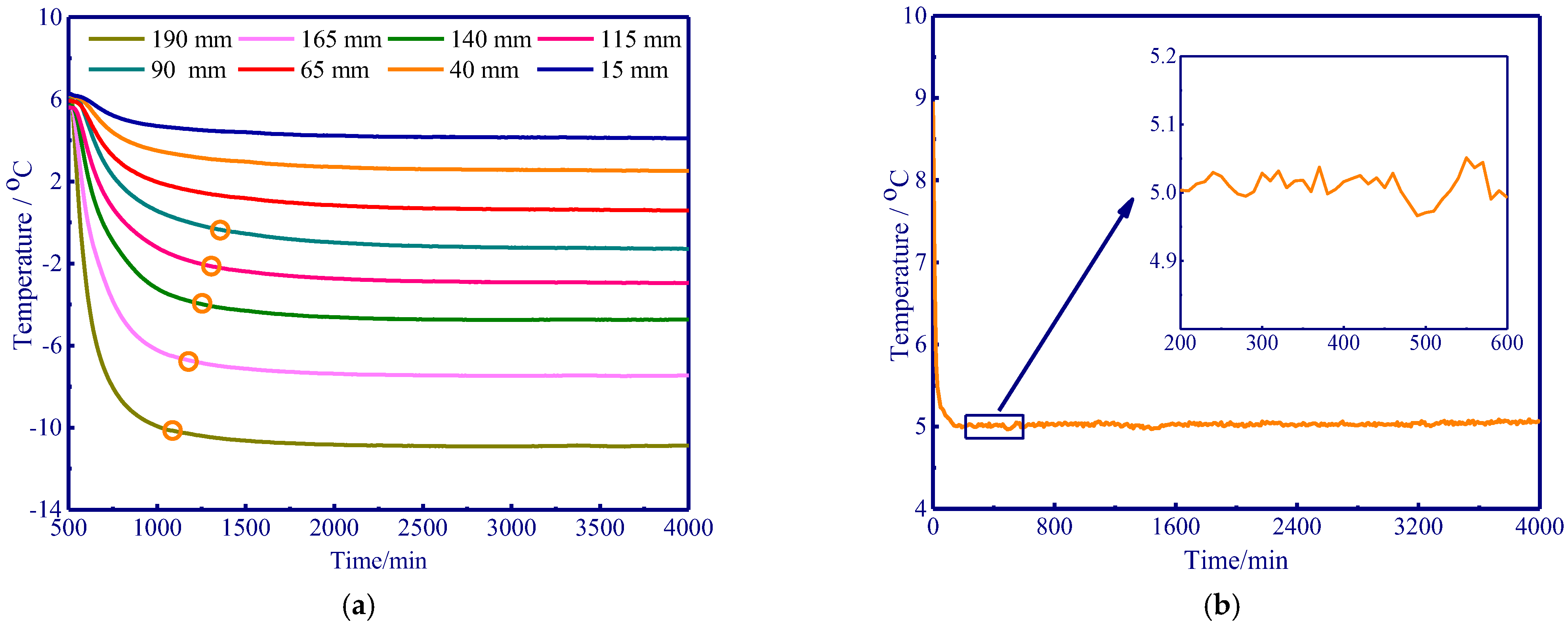

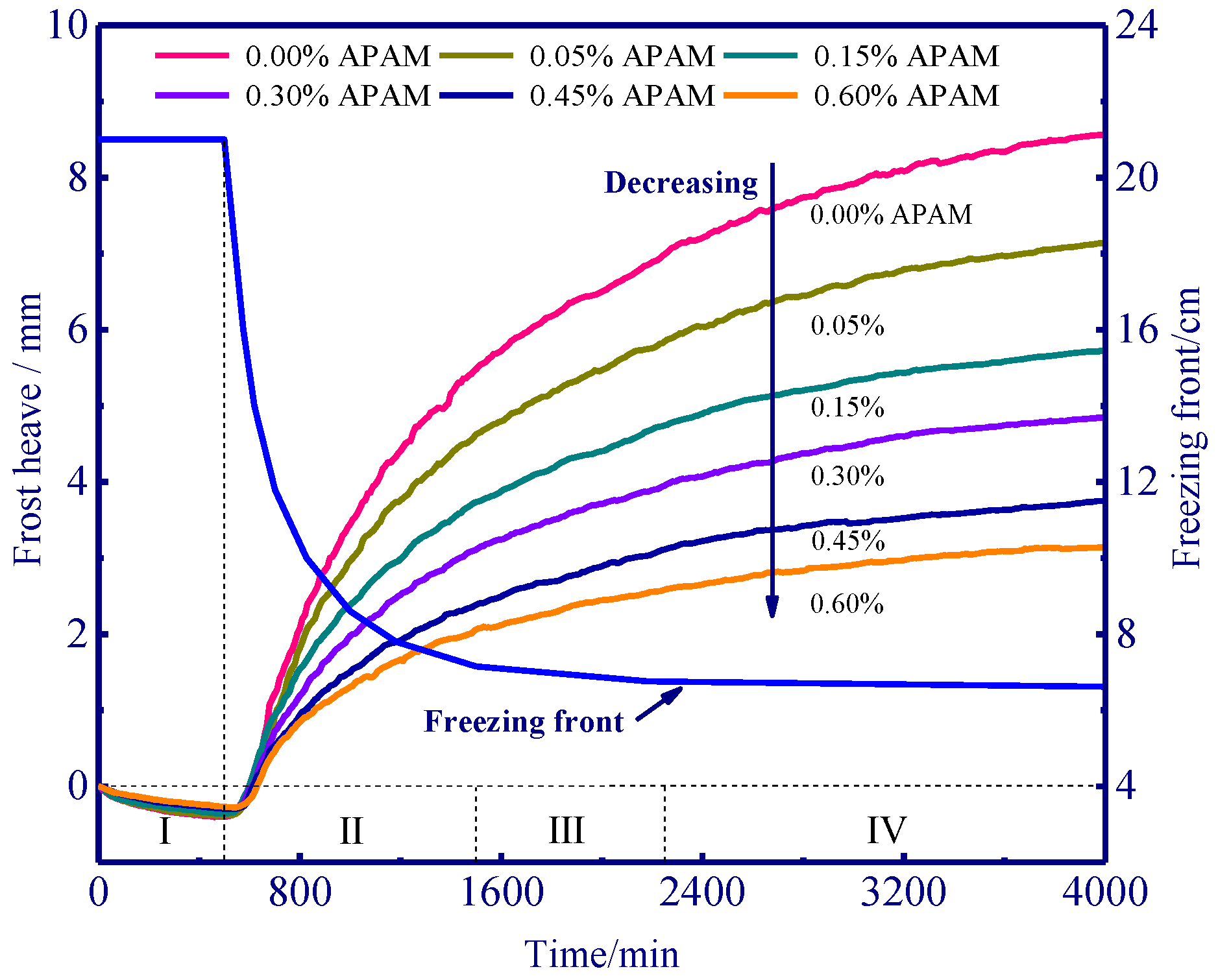
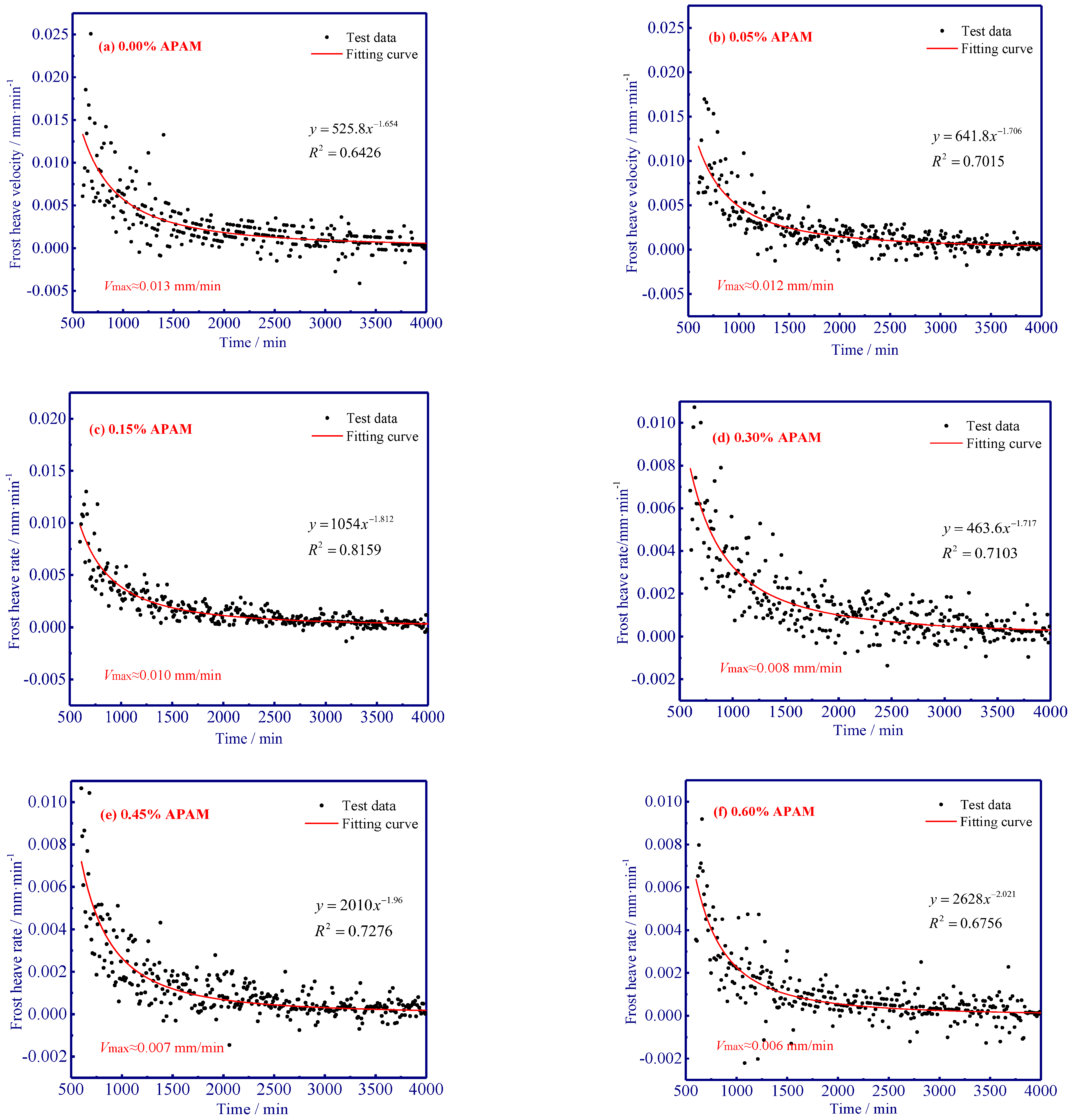
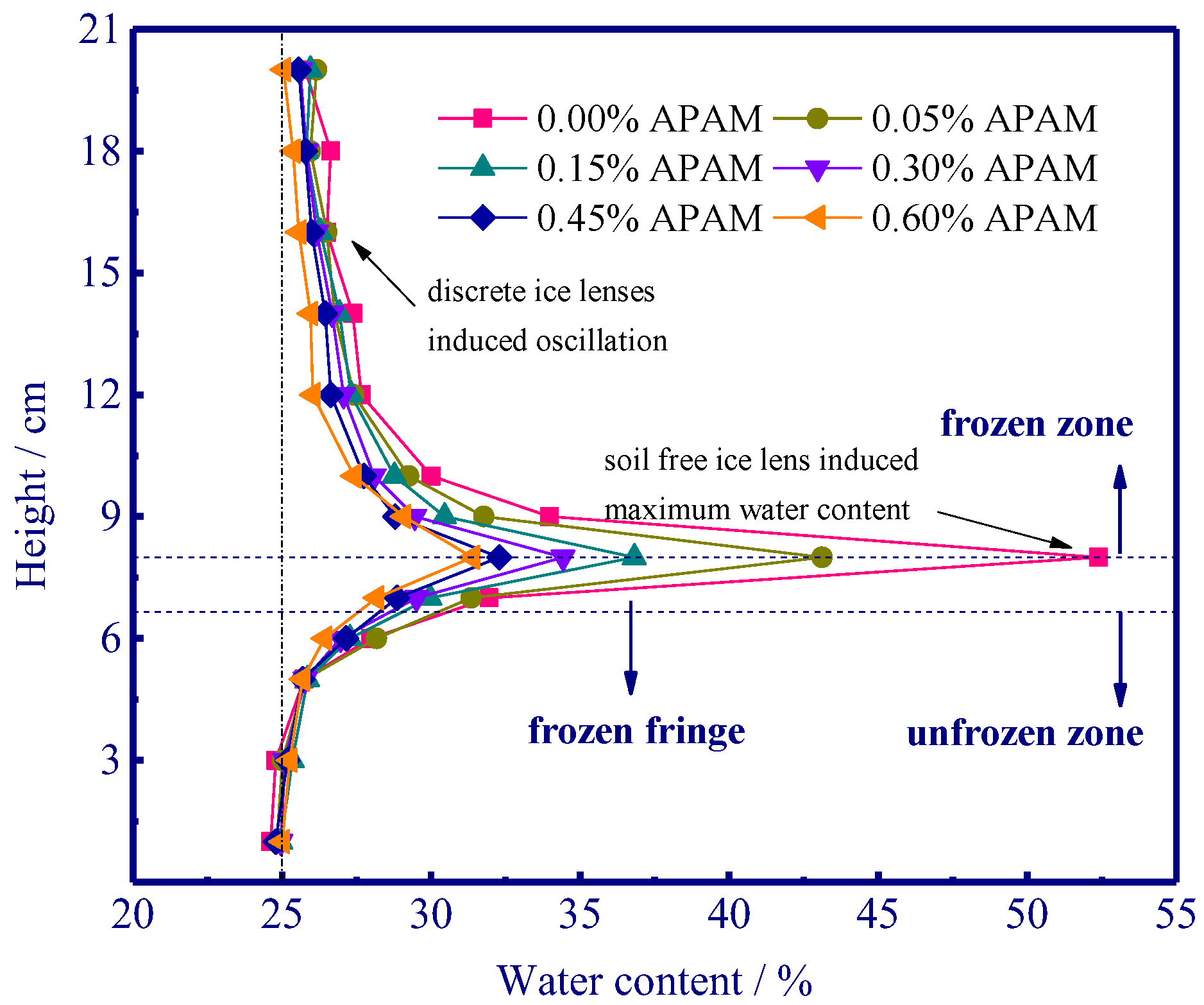


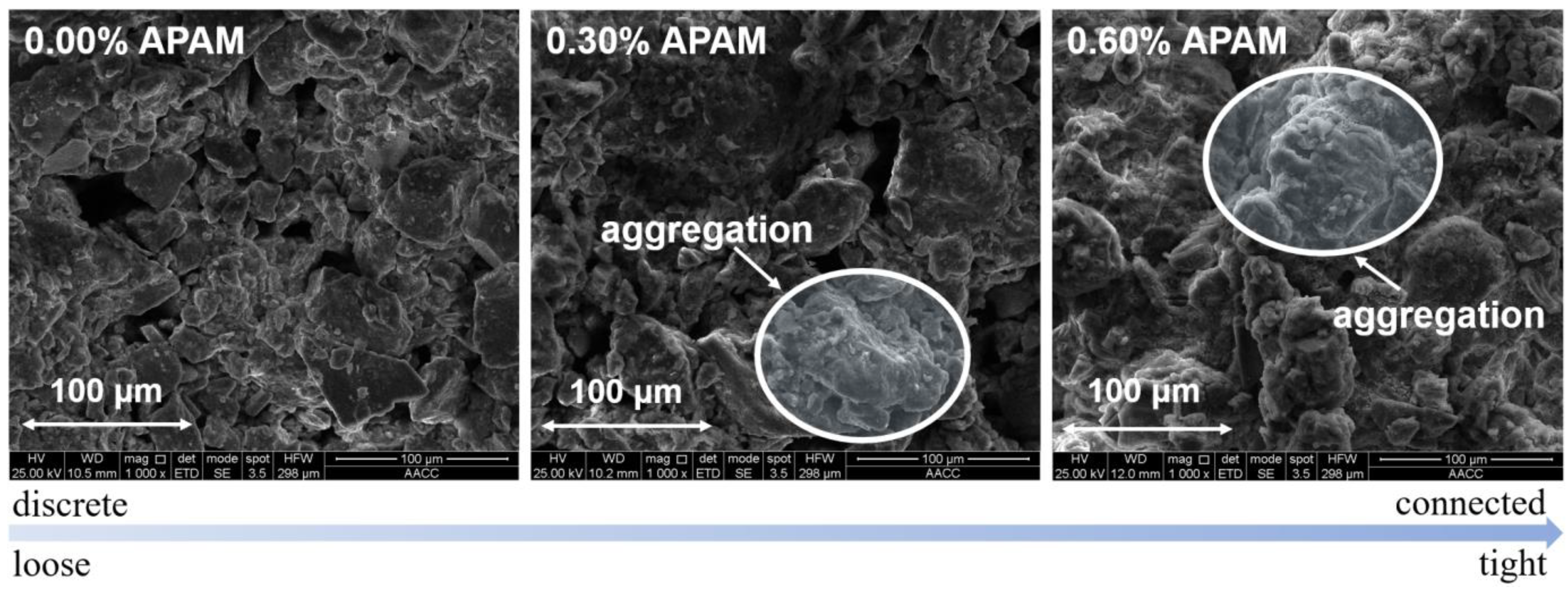

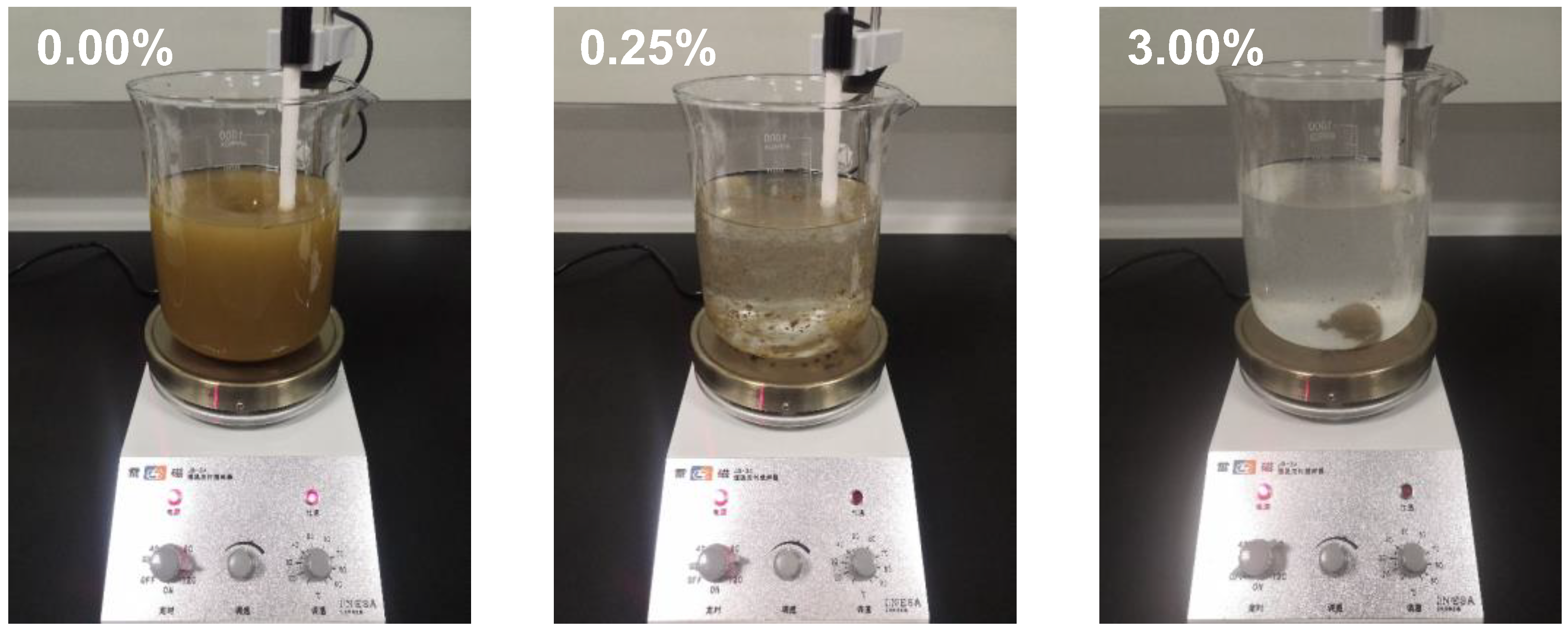


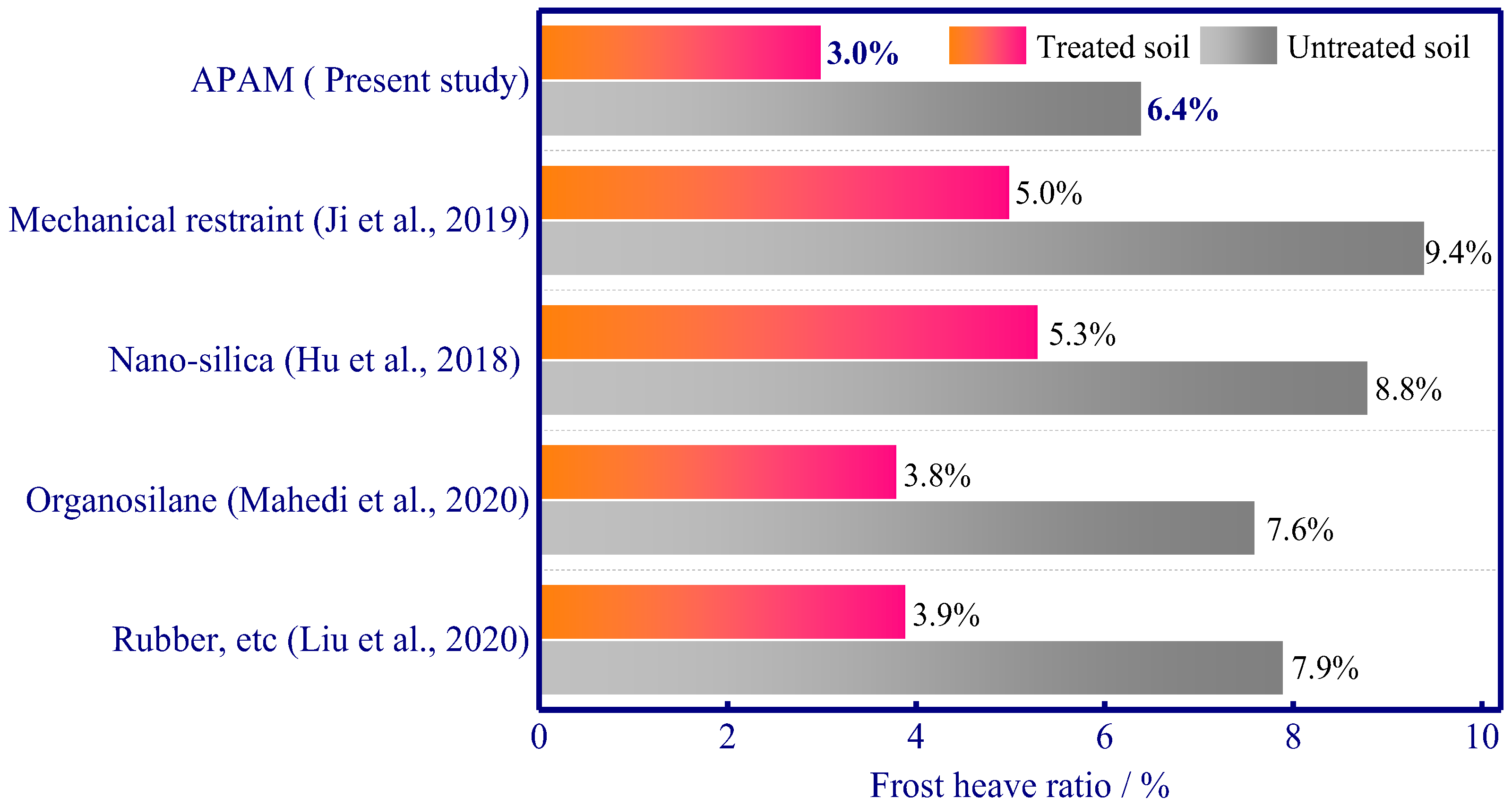
| Quartz | Illite/Smectite | Albite | Muscovite | Chlorite |
|---|---|---|---|---|
| 21% | 52% | 9% | 10% | 8% |
| Soil Type | Plastic Limit (%) | Liquid Limit (%) | Plastic Index | Water Content (%) | Dry Density (g/cm3) |
|---|---|---|---|---|---|
| Silty clay | 17.2 | 25.2 | 8 | 25 | 1.6 |
Disclaimer/Publisher’s Note: The statements, opinions and data contained in all publications are solely those of the individual author(s) and contributor(s) and not of MDPI and/or the editor(s). MDPI and/or the editor(s) disclaim responsibility for any injury to people or property resulting from any ideas, methods, instructions or products referred to in the content. |
© 2023 by the authors. Licensee MDPI, Basel, Switzerland. This article is an open access article distributed under the terms and conditions of the Creative Commons Attribution (CC BY) license (https://creativecommons.org/licenses/by/4.0/).
Share and Cite
Ji, Y.; Wang, H.; Li, X.; Zhao, P.; Wang, Q.; Li, R.; Vandeginste, V. Effect of Anionic Polyacrylamide Polymer on Frost Heave Mitigation and Its Implication for Frost-Susceptible Soil. Polymers 2023, 15, 2096. https://doi.org/10.3390/polym15092096
Ji Y, Wang H, Li X, Zhao P, Wang Q, Li R, Vandeginste V. Effect of Anionic Polyacrylamide Polymer on Frost Heave Mitigation and Its Implication for Frost-Susceptible Soil. Polymers. 2023; 15(9):2096. https://doi.org/10.3390/polym15092096
Chicago/Turabian StyleJi, Yukun, Haihang Wang, Xiaozhao Li, Peng Zhao, Qinke Wang, Ruilin Li, and Veerle Vandeginste. 2023. "Effect of Anionic Polyacrylamide Polymer on Frost Heave Mitigation and Its Implication for Frost-Susceptible Soil" Polymers 15, no. 9: 2096. https://doi.org/10.3390/polym15092096







